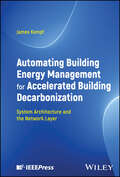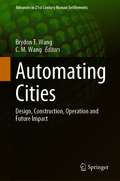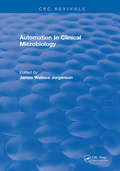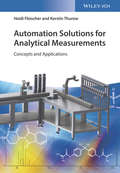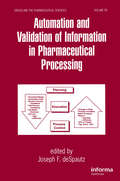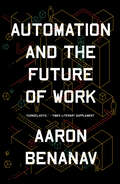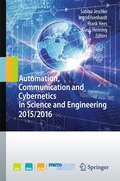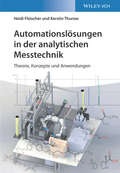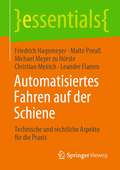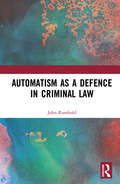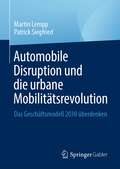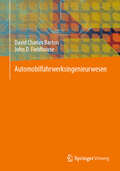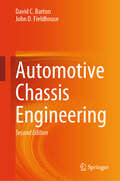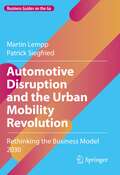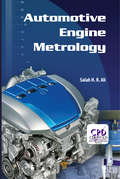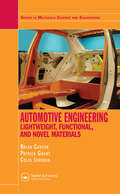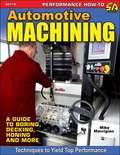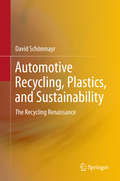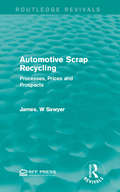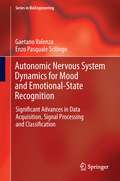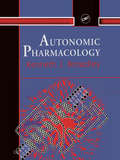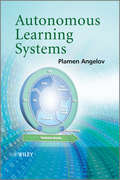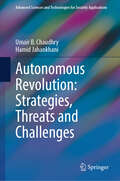- Table View
- List View
Automating Building Energy Management for Accelerated Building Decarbonization: System Architecture and the Network Layer
by James KempfComplete, up-to-date reference on system architecture for building energy management systems Automating Building Energy Management for Accelerated Building Decarbonization delivers detailed technical information on building energy management control technology and guidelines to implementing and deploying building energy management systems. The book provides a detailed look at the system architecture of cloud-based building energy management systems, and a comprehensive review of technology for the networking layer, from the link layer through the application layer. Wired and wireless link layer protocols, and Internet network layer protocols from the TCP/IP suite are thoroughly reviewed, and discussed in the context of deploying an in-building, operational technology network. At the application layer, BACnet, for large commercial and government buildings, and Bluetooth Low Energy, Zigbee, and Matter, for smaller commercial and residential buildings, are discussed in detail, with focus on energy management and building decarbonization. The API standards OpenAPI 3.1 and AsyncAPI 3.0 are used to define example APIs for controlling an HVAC system, illustrating how to provide API abstractions that simplify the development of building energy management applications and services. Finally, a discussion of controlling onsite distributed energy resources, such as solar panels and on-site battery storage, through SunSpec Modbus, and communicating with the utility through OpenADR and IEEE 2030.5 provide a solid technical foundation for implementing communication services in demand response and flexible load applications. Security is emphasized as a key property for the operational technology networks that run building energy systems up and down the stack. At the architectural level, security functions including data origin authentication, confidentiality protection, and key exchange are discussed in detail. Detailed information on security protocols including IPsec at the network layer, TLS at the transport layer, and Oauth2.0 at the application layer is presented. In addition, advice on deploying security solutions in building energy management networks is provided. Throughout the book, QR codes provide access to short videos about topics where more depth is needed or that are only briefly covered. These allow the reader to view more information about important topics. Automating Building Energy Management for Accelerated Building Decarbonization is an essential resource for managers, engineers, and other professionals involved in designing and building energy management services for commercial and residential buildings. It is also an excellent reference for university and training courses related to building decarbonization and renewable energy.
Automating Cities: Design, Construction, Operation and Future Impact (Advances in 21st Century Human Settlements)
by C. M. Wang Brydon T. WangThis book highlights the latest advancements in the use of automated systems in the design, construction, operation and future of the built environment and its occupants. It considers how the use of automated decision-making frameworks, artificial intelligence and other technologies of automation are presently impacting the practice of architects, engineers, project managers and contractors, and articulates the near future changes to workflows, legal frameworks and the wider AEC industry. This book surveys and compiles the use of city apps, robots that operate buildings and fabricate structural elements, 3D printing, drones, sensors, algorithms, and advanced prefabricated modules. The book also contributes to the growing literature on smart cities, and explores the impacts on data privacy and data sovereignty that arise through the use of sensors, digital twins and intelligent transport systems. It provides a useful reference for further research and development in the area of automation in design and construction to architects, engineers, project managers, superintendents and construction lawyers, contractors, policy makers, and students.
Automation In Clinical Microbiology
by James Wallace JorgensonThe chapters of this book describe numerous successful examples of automation in microbiology, e.g., radiometric detection of bacteremia, instruments for detection of bacteriuria, machines for organism identification and susceptibility testing, and automated antigen and antibody measurement systems. In addition, there are discussions of exciting but not yet proven methodologies such as chromatography, flow cytometry, and other applications of radiometry. There are also important discussions regarding improved means of data communication and ways to improve the clinician‘s use of test results. Lastly, there are candid assessments of the best and worst aspects of the current spectrum of automated instruments for microbiology. It is hoped that the reader of this volume will be left with a feeling of excitement at the possibilities that lie ahead for application of instrument techniques in the diagnosis of infectious diseases.
Automation Solutions for Analytical Measurement: Theory, Concepts, and Applications
by Heidi Fleischer Kerstin ThurowThe first book dedicated specifically to automated sample preparation and analytical measurements, this timely and systematic overview not only covers biological applications, but also environmental measuring technology, drug discovery, and quality assurance. Following a critical review of realized automation solutions in biological sciences, the book goes on to discuss special requirements for comparable systems for analytical applications, taking different concepts into consideration and with examples chosen to illustrate the scope and limitations of each technique.
Automation and Validation of Information in Pharmaceutical Processing (Drugs and the Pharmaceutical Sciences)
by Joseph F. deSpautzThis thoroughly authoritative work furnishes organizational, technological, validation, project management, and business perspectives on pharmaceutical information automation from industry and system automation professionals-demonstrating how to fulfill computer system validation requirements for hardware, applications, networks, data center operat
Automation and the Future of Work
by Aaron BenanavA consensus-shattering account of automation technologies and their effect on workplaces and the labor marketSilicon Valley titans, politicians, techno-futurists and social critics have united in arguing that we are living on the cusp of an era of rapid technological automation, heralding the end of work as we know it. But does the much-discussed &“rise of the robots&” really explain the jobs crisis that awaits us on the other side of the coronavirus? In Automation and the Future of Work, Aaron Benanav uncovers the structural economic trends that will shape our working lives far into the future. What social movements, he asks, are required to propel us into post-scarcity, if technological innovation alone can&’t deliver it? In response to calls for a universal basic income that would maintain a growing army of redundant workers, he offers a counter-proposal.
Automation, Communication and Cybernetics in Science and Engineering 2015/2016
by Sabina Jeschke Ingrid Isenhardt Frank Hees Klaus HenningAutomation, Communication and Cybernetics in Science and Engineering 2015/2016
Automationslösungen in der analytischen Messtechnik: Theorie, Konzepte und Anwendungen
by Heidi Fleischer Kerstin ThurowDas Buch behandelt die Entwicklung und Systematisierung geeigneter Automatisierungssysteme in der analytischen Messtechnik. Anwendungen aus verschiedenen Bereichen werden vorgestellt, beispielsweise aus der Umweltmesstechnik, Arzneimittelentwicklung und Qualitätssicherung.
Automatische Rauchwarnmelder zur Brand-Früherkennung: Eine Einführung für Feuerwehren
by Adam MerschbacherDieses Buch soll dazu beitragen, dass Rauchmelder durch Auswahl und Montage zuverlässig Schäden und Rauchopfer, sowie Falschmeldungen vermeiden. Außerdem schafft es Klarheit darüber, wer für was verantwortlich ist.
Automatisiertes Fahren auf der Schiene: Technische und rechtliche Aspekte für die Praxis (essentials)
by Friedrich Hagemeyer Malte Preuß Michael Meyer zu Hörste Christian Meirich Leander FlammGetrieben durch akuten Fachkräftemangel besteht im Fernbahnbetrieb Bedarf an einer durchgreifenden Automatisierung unter Einsatz modernster Technologien. Chancen für eine wirtschaftliche Umsetzung bietet ein hochassistierter Betrieb, mit dem die Anforderungen an die Ausbildung von Triebfahrzeugführern radikal reduziert werden. In der vorliegenden Analyse werden die derzeitigen Tätigkeitsfelder eines Triebfahrzeugführers denen in einem vollautomatischen bzw. hochassistierten Bahnbetrieb hinsichtlich der rechtlichen und betrieblichen Randbedingungen gegenübergestellt. Dabei stellt der vollautomatische Bahnbetrieb in der regulatorischen Fragestellung den komplexesten Betrachtungsfall dar.
Automatism as a Defence
by John RumboldAutomatism is a notoriously difficult subject for law students, lawyers and judges. This book explores the science and medicine of sleep disorders and examines how the criminal process deals with such disorders when presented as a defence. It systematically examines the legal doctrines involved, and their implications for the use of the evidence key to establishing automatism, while also exploring the medical conditions that can cause automatism (particularly epilepsy, sleepwalking and diabetes). This book is a valuable resource for law students, lawyers, judges and expert witnesses.
Automobile Disruption und die urbane Mobilitätsrevolution: Das Geschäftsmodell 2030 überdenken
by Martin Lempp Patrick SiegfriedDieses Buch bietet eine integrierte Perspektive des Automobilmarktes für das nächste Jahrzehnt. Es zeigt, wie Kunden und Hersteller den Markt gleichzeitig gestalten, und führt an, dass die ersten Schritte der Mobilitätsrevolution bereits unternommen worden sind. Sie zwingt die Automobilunternehmen, neue Wege zu gehen, um im Bestreben nach Wandel und Innovation nicht auf der Strecke zu bleiben.Die Autoren liefern eine umfassende Analyse der Automobilindustrie, einschließlich der vorherrschenden Geschäftsmodelle von OEMs und 'Tier-n'-Automobilzulieferern, des Wettbewerbsumfelds, in das sie eingebettet sind, sowie der sozioökonomischen Veränderungen, die die künftigen Marktbedingungen beeinflussen. Anschließend werden Elemente der automobilen Disruption vorgestellt, die neuartige urbane Mobilitätskonzepte ermöglichen und eine neue Quelle für zusätzliche, den Nutzer begleitende Dienstleistungen bieten. Ein umfassender Einblick in das Konsumentenverhalten, potenzielle automobile Geschäftsmodelle, die bis 2030 Bestand haben können, Smart-City-Modelle, Transformationsstrategien und verschiedene Marktpenetrationsszenarien werden in dem Buch ebenfalls gegeben. Darüber hinaus werden die Herausforderungen und Schlüsselmaßnahmen skizziert, die den Automobilsektor auch über das Jahr 2030 hinaus prägen werden, sowie die Auswirkungen der technologischen und wirtschaftlichen Veränderungen im Automobilmarkt auf verschiedene Branchen prognostiziert.
Automobilfahrwerksingenieurwesen
by John D. Fieldhouse David Charles BartonFür Studierende und Praktiker im Bereich Fahrzeugtechnik geschrieben, bietet dieses Buch ein grundlegendes, aber umfassendes Verständnis der Fahrwerksysteme und erfordert nur geringe Vorkenntnisse seitens der Leser. Es präsentiert das Material auf praktische und realistische Weise und verwendet Reverse Engineering als Grundlage für Beispiele, um das Verständnis der Themen zu verstärken. Die Spezifikationen und Merkmale von Fahrzeugen, die derzeit auf dem Markt sind, werden genutzt, um die Anwendung der Theorie zu veranschaulichen, und es wird darauf geachtet, die verschiedenen behandelten Themen zu verbinden, um ihre Zusammenhänge klar darzustellen. Diese zweite Auflage ist vollständig aktualisiert und überarbeitet und umfasst ein neues Kapitel zum Verzögerungsverhalten von Fahrzeugen. Das Buch beginnt mit einem Kapitel über grundlegende Fahrzeugmechanik, das die auf ein sich bewegendes Fahrzeug wirkenden Kräfte unter der Annahme eines starren Körpers behandelt. Das neue Kapitel über das Verzögerungsverhalten von Fahrzeugen führt die grundlegenden Konzepte eines herkömmlichen Bremsystems ein, bevor es Möglichkeiten zur Optimierung der Verzögerungsleistung eines jeden radgebremsten Fahrzeugs basierend auf den Haftungsverhältnissen von Reifen und Straße betrachtet. Das nächste Kapitel konzentriert sich auf die Fahrzeugdynamik, indem es die Federungssysteme und die Interaktion der wichtigen Komponenten des Systems, wie Reifen, Verbindungen, Federn, Stoßdämpfer usw., zur Erzielung der erforderlichen Leistungsmerkmale des Fahrzeugs untersucht. Das Buch fährt dann mit einem Kapitel über Lenksysteme fort, das den Lesern ein fundiertes Verständnis der Prinzipien und Kräfte unter statischer und dynamischer Belastung vermittelt. Das Kapitel über Fahrwerksstrukturen und -materialien skizziert Analysetools (typischerweise Finite-Elemente-Analyse) und Designmerkmale, die zur Reduzierung der Masse und Erhöhung der Sicherheit der Insassen in modernen Fahrzeugen verwendet werden. Das abschließende Kapitel über Geräusche, Vibrationen und Harshness (NVH) bietet einen grundlegenden Überblick über Akustik- und Vibrationslehre und nutzt umfangreiche Forschungsuntersuchungen und praktische Erfahrungen, um NVH-Probleme zu behandeln. In allen Fachbereichen berücksichtigen die Autoren die neuesten Trends, einschließlich der Entwicklung hin zu Elektrofahrzeugen, On-Board-Diagnoseüberwachung, aktiven Systemen und Leistungsoptimierung. Das Buch enthält zahlreiche durchgerechnete Beispiele und Fallstudien, die auf aktuellen Forschungsprojekten basieren. Alle Studierenden, einschließlich der Masterstudierenden im Bereich Fahrzeugtechnik, sowie Fachleute aus der Industrie, die ein besseres Verständnis der Fahrzeugchassistechnik erlangen möchten, werden von diesem Buch profitieren.
Automotive Chassis Engineering
by David C. Barton John D. FieldhouseWritten for students and practising engineers working in automotive engineering, this book provides a fundamental yet comprehensive understanding of chassis systems and requires little prior knowledge on the part of the reader. It presents the material in a practical and realistic manner, using reverse engineering as a basis for examples to reinforce understanding of the topics. The specifications and characteristics of vehicles currently on the market are used to exemplify the theory’s application, and care is taken to connect the various topics covered, so as to clearly demonstrate their interrelationships. This second edition is fully updated and revised throughout and includes a new chapter on vehicle deceleration behaviour. The book opens with a chapter on basic vehicle mechanics, which includes the forces acting on a vehicle in motion, assuming a rigid body. The new chapter on vehicle deceleration behaviour introduces the basic concepts of a conventional foundation braking system before considering means of optimising the deceleration performance of any wheel-braked vehicle based on the tyre-road adhesion characteristics. The next chapter focuses on vehicle dynamics by considering suspension systems and how the important components of the system, the tyres, linkages, springs, dampers, etc., interact to give the required peformance characteristics for the vehicle. The book then proceeds to a chapter on steering systems, which provides readers with a firm understanding of the principles and forces involved under static and dynamic loading. The chapter on chassis structures and materials outlines analysis tools (typically, finite element analysis) and design features that are used to reduce mass and increase occupant safety in modern vehicles. The final chapter on noise, vibration and harshness (NVH) includes a basic overview of acoustic and vibration theory and makes use of extensive research investigations and practical experience asa means of addressing NVH issues. In all subject areas, the authors take into account the latest trends, anticipating the move towards electric vehicles, on-board diagnostic monitoring, active systems and performance optimisation. The book features a number of worked examples and case studies based on recent research projects. All students, including those on Master level degree courses in automotive engineering, and professionals in industry who want to gain a better understanding of vehicle chassis engineering, will benefit from this book.
Automotive Disruption and the Urban Mobility Revolution: Rethinking the Business Model 2030 (Business Guides on the Go)
by Martin Lempp Patrick SiegfriedThis book provides an integrated perspective of the automotive market for the next decade. It shows how customers and producers are shaping the market simultaneously and contends that the first steps of the mobility revolution have already been taken. It compels automotive companies to strike new paths to participate in this journey.The authors provide a comprehensive analysis of the automotive industry, including prevailing business models of OEMs and 'tier-n' automotive suppliers, the competitive environment they are embedded in as well as socio-economic changes affecting future market conditions. Subsequently, elements of the automotive disruption are presented; these enable the provision of novel urban mobility concepts and offer a new source for additional services accompanying the user. A comprehensive insight into consumer behavior, potential automotive business models which can be sustained by 2030, smart city models, transformation strategies, and diverse market penetration scenarios are also provided in the book. It also outlines the challenges and key actions that shape the automotive sector even beyond 2030 as well as knock-on effects across different industries arising from the technological and economic changes in the automotive market are projected.
Automotive Engine Metrology
by Salah H. AliIn recent decades, metrology—an accurate and precise technology of high quality for automotive engines—has garnered a great deal of scientific interest due to its unique advanced soft engineering techniques in design and diagnostics. Used in a variety of scientific applications, these techniques are now widely regarded as safer, more efficient, and more effective than traditional ones. This book compiles and details the cutting-edge research in science and engineering from the Egyptian Metrology Institute (National Institute for Standards) that is revolutionizing advanced dimensional techniques through the development of coordinate and surface metrology.
Automotive Engineering: Lightweight, Functional, and Novel Materials (Series in Materials Science and Engineering)
by Patrick Grant Colin Johnston Brian CantorThe current automotive industry faces numerous challenges, including increased global competition, more stringent environmental and safety requirements, the need for higher performance vehicles, and reducing costs. The materials used in automotive engineering play key roles in overcoming these issues. Automotive Engineering: Lightweight, Functional
Automotive Machining: A Guide To Boring, Decking, Honing And More
by Mike MavrigianMachining is an essential part of high-performance engine building and stock rebuilding, as well as certain servicing procedures. Although you may not own the expensive tooling and machining to perform all or any of the machining required for a quality build, you need to understand the principles, procedures, and goals for machining, so you can guide the machining process when outsourced. Classic and older engines typically require extensive machining and almost every major component of engine, including block, heads, intake, crankshaft, and pistons, require some sort of machining and fitment. <p><p> A detailed, authoritative, and thorough automotive engine-machining guide for the hard-core enthusiast has not been available until now. Mike Mavrigian, editor of Engine Building Professional, walks you through each important machining procedure. A stock 300-hp engine build has far different requirements than a 1,000-hp drag race engine, and Mavrigian reveals the different machining procedures and plans according to application and engine design. The author also shows you how to inspect, measure, and evaluate components so you can provide astute guidance and make the best machine work choices. <p> Machining procedures included are cylinder boring, align boring/honing, decking, valveseat cutting, cam tunnel boring, and a multitude of other services. In addition, multi-angle valve jobs, setting the valveseats, altering rocker arm ratio, re-conditioning connecting rods, and machining and matching valvetrain components are also covered. Whether you're an enthusiast engine builder or prospective machining student who wants to pursue a career as an automotive machinist, this book will provide insight and in-depth instruction for performing the most common and important machining procedures.
Automotive Recycling, Plastics, and Sustainability
by David SchönmayrThis book provides transdisciplinary analyses of the automotive plastics production and recycling system, including prognoses, scenarios and solutions for corporate sustainability management.A book on plastics, not written by a plastics guy. But a sustainability guy. Plastics schizophrenia and the automotive abyss: The industry is facing a severe challenge. It is the inevitable and promising change towards a sustainable economy. However, the automotive industry is primarily concerned with the CO2 emissions from cars when driving, while the rise of lightweight plastics, electric drive and heavy batteries make the production and end-of-life phase ever more important. Therefore, the currently increasing use of non-sustainable virgin plastics in cars has to be tackled.The plastics and the automotive industry now have a chance, and this chance is the Recycling Renaissance.This book offers:• Holistic and transdisciplinary overview on sustainability and automotive plastics from all angles including economy, ecology, technology, and politics with a focus on Europe• Concise analyses, prognoses, tools and a roadmap with solutions for companies, developed together with international experts from industry and academia • Strong scientific basis and independent research including a Europe-wide survey, expert interviews, and workshops• More than 80 illustrations and 15 tables including a SCOT analysis • Executive summaries after each chapter for fast reading“The uniqueness of this book lies within the different point of view on this topic from a critical, outstanding scientist.” - Univ.-Prof. Dipl.-Ing. Dr.mont. Pomberger, Montanuni Leoben
Automotive Scrap Recycling: Processes, Prices and Prospects (Routledge Revivals)
by James. W SawyerAutomotive Scrap Recycling provides a qualitative description of the steel scrap industry by focussing on its largest segment: conversion of obsolete cars into steel scrap. Originally published in1974, this report covers issues such as the structure of the industry and quality problems with scrap steel as well as related policy issues. This title will be of interest to students of Environmental Studies.
Autonomic Nervous System Dynamics for Mood and Emotional-State Recognition: Significant Advances in Data Acquisition, Signal Processing and Classification (Series in BioEngineering)
by Gaetano Valenza Enzo Pasquale ScilingoThis monograph reports on advances in the measurement and study of autonomic nervous system (ANS) dynamics as a source of reliable and effective markers for mood state recognition and assessment of emotional responses. Its primary impact will be in affective computing and the application of emotion-recognition systems. Applicative studies of biosignals such as: electrocardiograms; electrodermal responses; respiration activity; gaze points; and pupil-size variation are covered in detail, and experimental results explain how to characterize the elicited affective levels and mood states pragmatically and accurately using the information thus extracted from the ANS. Nonlinear signal processing techniques play a crucial role in understanding the ANS physiology underlying superficially noticeable changes and provide important quantifiers of cardiovascular control dynamics. These have prognostic value in both healthy subjects and patients with mood disorders. Moreover, Autonomic Nervous System Dynamics for Mood and Emotional-State Recognition proposes a novel probabilistic approach based on the point-process theory in order to model and characterize the instantaneous ANS nonlinear dynamics providing a foundation from which machine "understanding" of emotional response can be enhanced. Using mathematics and signal processing, this work also contributes to pragmatic issues such as emotional and mood-state modeling, elicitation, and non-invasive ANS monitoring. Throughout the text a critical review on the current state-of-the-art is reported, leading to the description of dedicated experimental protocols, novel and reliable mood models, and novel wearable systems able to perform ANS monitoring in a naturalistic environment. Biomedical engineers will find this book of interest, especially those concerned with nonlinear analysis, as will researchers and industrial technicians developing wearable systems and sensors for ANS monitoring.
Autonomic Pharmacology
by Kenneth J BroadleyThis overview of autonomic pharmacology describes the anatomy, physiology and pharmacology of the autonomic involuntary nervous system. Covering the diverse group of drugs acting on the autonomous nervous system, their actions are reviewed together with their clinical uses, side effects, interactions and subcellular mechanisms of action. Information is organized in a logical flow, bringing together the latest advances in an integrated form on topics usually found only in a fragmented form.; This work is intended for all those researching in industry and academic institutions in pharmaceutical, pharmacological sciences, pharmacy, medical sciences, physiology, neurosciences, biochemistry and molecular biology.
Autonomous Agricultural Vehicles: Concepts, Principles, Components, and Development Guidelines
by Ali Roshanianfard Sina Faizollahzadeh ArdabiliThis comprehensive guide to agricultural robots is the ideal companion for any student or professional engineer looking to understand and develop autonomous vehicles to use on the modern farm. With world hunger one of the modern era’s most pressing issues, autonomous agricultural vehicles are a key tool in tackling this problem. Smart farming can increase total factory productivity through designing autonomous vehicles based on specific needs, in addition to implementing smart systems into day-to-day operations. This book provides step-by-step guidance, from the theory behind autonomous vehicles, through to the design process and manufacture. Detailing all components of an autonomous agricultural vehicle, from sensors, controlling algorithms, communication and controlling units, the book covers topics such as artificial intelligence and machine learning. It also includes case studies, and a detailed guide to international policymaking in recent years. Suitable for students and professionals alike, this book will be a key companion to those interested in agricultural engineering, autonomous vehicles, robotics, and mechatronics, in mechanical, automotive, and electrical engineering.
Autonomous Learning Systems
by Plamen AngelovAutonomous Learning Systems is the result of over a decade of focused research and studies in this emerging area which spans a number of well-known and well-established disciplines that include machine learning, system identification, data mining, fuzzy logic, neural networks, neuro-fuzzy systems, control theory and pattern recognition. The evolution of these systems has been both industry-driven with an increasing demand from sectors such as defence and security, aerospace and advanced process industries, bio-medicine and intelligent transportation, as well as research-driven - there is a strong trend of innovation of all of the above well-established research disciplines that is linked to their on-line and real-time application; their adaptability and flexibility.Providing an introduction to the key technologies, detailed technical explanations of the methodology, and an illustration of the practical relevance of the approach with a wide range of applications, this book addresses the challenges of autonomous learning systems with a systematic approach that lays the foundations for a fast growing area of research that will underpin a range of technological applications vital to both industry and society. Key features: Presents the subject systematically from explaining the fundamentals to illustrating the proposed approach with numerous applications.Covers a wide range of applications in fields including unmanned vehicles/robotics, oil refineries, chemical industry, evolving user behaviour and activity recognition.Reviews traditional fields including clustering, classification, control, fault detection and anomaly detection, filtering and estimation through the prism of evolving and autonomously learning mechanisms.Accompanied by a website hosting additional material, including the software toolbox and lecture notes.Autonomous Learning Systems provides a 'one-stop shop' on the subject for academics, students, researchers and practicing engineers. It is also a valuable reference for Government agencies and software developers.
Autonomous Revolution: Strategies, Threats and Challenges (Advanced Sciences and Technologies for Security Applications)
by Hamid Jahankhani Umair B. ChaudhryThis book offers a comprehensive dive into the rapidly evolving world of autonomous vehicles and their pivotal role in modern data collection and mission-critical operations. From unmanned vehicles (UVs) navigating complex urban landscapes to traversing remote environments, the integration of advanced algorithms and cloud-based infrastructure enables real-time data acquisition and processing. Topics covered include resilient navigation systems, bio-inspired evolution for safer collaboration, and the crucial governance and security challenges facing land, air, and sea-based UVs. Additionally, the book explores emerging threats, such as cyber-physical vulnerabilities, counter-drone technologies, and the need for secure Flying Ad-Hoc Networks (FANETs). The future of UVs is further examined through the lens of quantum computing, pushing the boundaries of autonomous navigation and decision-making. By compiling these scattered and essential topics into one resource, this book serves as a vital reference for professionals, researchers, and policymakers seeking to understand and shape the future of autonomous systems.
